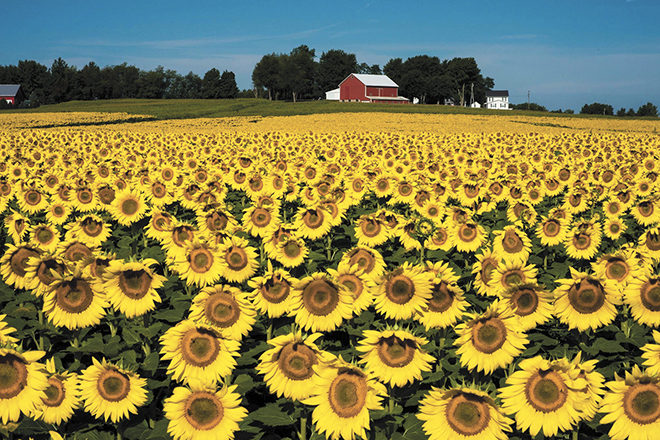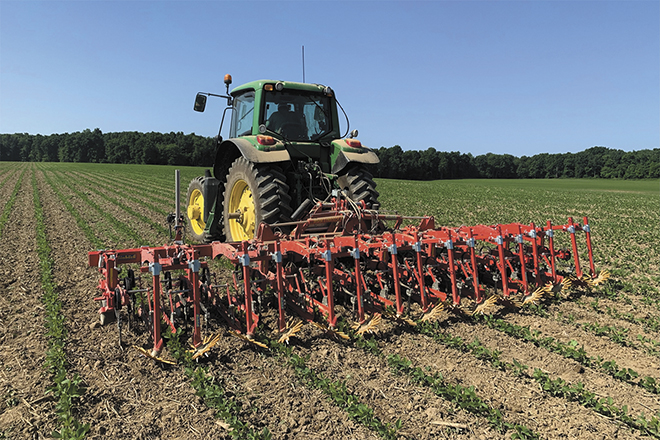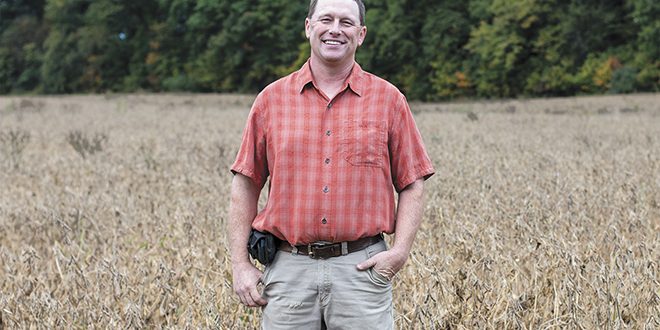By Brianna Gwirtz, Ohio Country Journal field reporter
The most dangerous phrase to any multigenerational business is, “Well, that’s the way we’ve always done it.”
Scott Myers is the third generation to farm at Woodlyn Acres Farm in Dalton. While away in college at the Ohio State University, Myers focused all his time on figuring out ways to return to the farm following graduation. In 2000, Myers started a hay business, selling to mainly local dairymen, and was able to return home to the farm.
When milk prices started a downturn nearly a decade ago, many of his dairy customers transitioned to organic milk production in order to find a niche market. Myers saw an opportunity and his own niche market, so Woodlyn Acres followed suit.
“Organic dairies are what got us considering switching our own fields,” Myers said. “I wanted to be able to support my customers.”
The transition to being certified organic started very slowly. Myers started with his best fields, planting them to hay and some corn, resulting in around 90 to 100 acres of organic crops. The original intent was to be a parallel operation, growing both conventional and organic commodities. It wasn’t long before Myers changed his mind.
“We had a market and we really grew into it,” he said.
Today, Woodlyn Acres Farm is in its sixth year of certified organic crop production, with around 2,500 acres producing hay, corn, soybeans, sunflowers, peas, barley, oats and cereal rye. Myers works alongside his father, Fred Myers, as well as four other full-time employees to manage the crops. They are joined on the farm by Fred’s wife, Cheryl, and Scott’s wife, Nicole, as well as Scott’s four sons.
“We do a lot of different things. We joke that we’ve been cover cropping for years, since hay is a perennial long-term crop,” Myers said.
Every crop rotation is very intentional.
“We harvest corn at a fairly high moisture, then dry it down, that way we have time to get in a cereal rye for the cover crop. In late May then, when the rye is flowering, we will no-till soybeans into it and then roll and crimp the rye,” Myers said.
Cover crops are planted before corn as well, usually winter peas, clover or vetch. This combination grows into the spring, before a high-speed disc is used to knock the plants down. There is often some sort of cover crop in place following barley and rye harvest.
“We can basically raise 75% of our nitrogen with cover crops,” Myers said. “My goal is to have every acre covered at all times throughout the year. We are not all the way there yet, but we are getting close.”
Sunflowers are a fairly new crop on the farm and to the area. Once harvested, the seeds are sent for crushing into oil and the meal is utilized for chicken feed. Myers double-crops the sunflowers behind barley.
“We love the sunflowers so far. They’ve got a wide planting season, which is nice. It seems like the ones you plant later tend to have higher yields. They really seem to like the hot, dry weather,” Myers said.

Sunflowers like hot, dry growing conditions and have a wide planting window. Photo by Scott Myers.
About one-third of their acreage remains in organic hay. They bale high-moisture, wrapped hay and market to mostly local dairy customers. It’s mainly alfalfa, but does include some orchardgrass, fescue and ryegrass.
The process of becoming certified organic came with a significant learning curve. While all types of farming come with challenges, the limitations and regulations associated with being organic were new to Myers. Weed control is an area he has really learned to focus on.
“Weed control in organic production is a very timely thing. There’s about a six-week period from late May into June that I tend to get a little stressed,” Myers says. “We don’t have the option to go back in later with a chemical and save the crop if the weeds get too bad.”
One of the new technologies the Myers family brought to the farm was a weed zapper. The tool hits the weeds and electrocutes the plant to the ground. This past year they utilized the tool on about one-fifth of their soybean acres. They also use cultivators and tine weeders to clear between rows.
“The money we would’ve normally spent on chemicals in the past we’ve invested into equipment instead,” he said. “Our goal is to have enough cultivators that we can cultivate as many fields as we would have been able to spray in a day when we were conventional. Right now we can cultivate about 300 acres a day running four eight-row cultivators.”
The cultivators are equipped with cameras that see the rows. As soon as the camera sees color or pattern changes, the cultivator will steer itself. The tool allows the cultivators to come within a half-inch of the plant.
Soil samples are taken every three years as part of their organic certification. In addition to utilizing cover crops to fix nitrogen and provide a “green manure,” Woodlyn Acres also uses chicken manure. Since the hay does get sold off the farm, some nutrients do have to be added back into the soil. They are allowed to use some fertilizers, lime and gypsum, although they all have to be approved for organic production.
“Our soil tests have gone up every year,” Myers said. “It’s amazing how many earth worms we have now. You don’t realize how hard some of the conventional practices can be to soil life, especially to earth worms. Our earth worm numbers are way higher now. In fact sometimes, we’ve had issues when we try to interseed a crop into a standing crop, the earth worms take the seed down in their holes and then nothing grows.”
Myers has noticed that a lot of his crop residue breaks down a lot faster now than when he was conventional as well.
“We really had pretty good organic matter levels to start with before changing to organic. I’m anxious to see this year’s soil tests,” he said. “We will see some definite improvement this year, as this will be the ninth year for some of the fields to be under this type of management.”

Careful cultivating is vital for weed control in the organic operation. Photo by Scott Myers.
This past August, Myers welcomed the Ohio Ecological Food and Farm Association, Natural Resources Conservation Service, local farmers, and area politicians to Woodlyn Acres to share more about the farm and the family’s transition to organic. The group took a tour of the farm and were able to meet in the afternoon.
“We used to get some pushback from conventional farmers when we first made the decision to go organic,” Myers said. “But the beauty of farming is that you can choose what you want to do. Organic is not for everyone. It’s another way to farm and another market available to us.”
Yields on Woodlyn Acres Farm are doing well. While the first few years of the transition period are always the hardest, as it takes three years of production before being able to sell commodities as organic, the changes Myers made back then are impacting his revenues now.
“While our jump to organic was a business decision, we also want to leave the land better than we found it,” he said. “Organic production is, in my eyes, a premium for good management and it pays us to improve our soil health, too.”
Reprinted with permission of Ohio Country Journal
To view original article, visit:
https://ocj.com/2021/11/the-successful-switch-to-organic/
Organic & Non-GMO Insights April 2022





